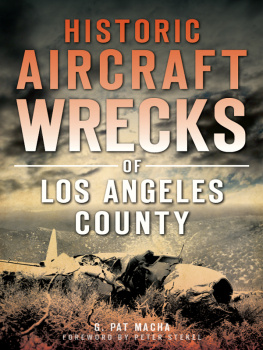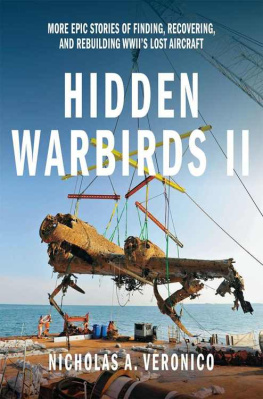HIDDEN
WARBIRDS
The Epic Stories of Finding,
Recovering, and Rebuilding
WWIIs Lost Aircraft
Nicholas A. Veronico


For Caroline and Ray and Armand and Karen
First published in 2013 by Zenith Press, an imprint of MBI Publishing Company, 400 First Avenue North, Suite 400, Minneapolis, MN 55401 USA
2013 Zenith Press
Text 2013 Nicholas A. Veronico
Unless noted otherwise all archival photos are from the authors collection and all contemporary photos were taken by the author.
All rights reserved. With the exception of quoting brief passages for the purposes of review, no part of this publication may be reproduced without prior written permission from the Publisher. The information in this book is true and complete to the best of our knowledge.
Zenith Press titles are also available at discounts in bulk quantity for industrial or sales-promotional use. For details write to Special Sales Manager at MBI Publishing Company, 400 First Avenue North, Suite 400, Minneapolis, MN 55401 USA.
To find out more about our books, join us online at www.zenithpress.com.
Digital Edition: 978-1-61058-811-9
Softcover Edition: ISBN: 978-0-76034-409-5
Library of Congress Cataloging-in-Publication Data
Veronico, Nick, 1961
Hidden warbirds : the epic stories of finding, recovering, and rebuilding WWIIs lost aircraft / Nick Veronico.
pages cm
Includes bibliographical references and index.
ISBN 978-0-7603-4409-5 (hbk.)
1. Airplanes, Military--Conservation and restoration--United States. 2. Airplanes, Military--Accidents--United States--History--20th century. 3. World War, 1939-1945--Aerial operations. I. Title.
UG1243.V469 2013
623.7460288--dc23
2012050971
Editor: Scott Pearson
Design: Chris Fayers
Cover design: Jason Gabbert
On the front cover: Shot down in February 1942, this B-17E became known as the Swamp Ghost and was the object of many failed recovery attempts. Charles Darby
On : Battle of Midway veteran SBD-2 Dauntless BuNo 2106 is returned to dry land after more than fifty-one years resting on the bottom of Lake Michigan. A&T Recovery via National Museum of Naval Aviation
10 9 8 7 6 5 4 3 2 1
Contents
Acknowledgments
When assembling a book like Hidden Warbirds, many old friends and many new friends are called upon for information, opinions, photos, and other resources. Their generosity is shown on these pages and woven into each of the stories. A special thanks to: Ian Abbott; Denis Arbeau; Frank Arrufat; Jim Azelton; Brian Baker; Gerald Balzer; Darlene and Roger Cain; Bob Cardin; Mike, Francis, Steve, and Robert Coutches; Charles Darby; Ed Davies; Mike DeCastro; Robert F. Dorr; Jim Dunn; Linda and Bruce Fenstermaker; Bill FischerEAA Warbirds; Rasa and Craig FullerAviation Archaeological Investigation and Research; Denny Ghiringhelli; Erik Gilg; Ric GillespieTIGHAR; Wayne Gomes; Jackie and Kevin Grantham; Dan Hagedorn; Fred Hagen; Lori Hahn; Eric HammelPacifica Military History; John Harjo; Alice Hendricks; Ted Holgerson; Vallarie Kilkenney-Jukes and Norm Jukes; Mike Kellner; Martin Kyburz; John LaneAirpower Unlimited; Peter Langsdale; Gary Larkins; Tillie and William T. Larkins; Dave Leininger; Gerry Liang; Ed Lindsay; Michael H. Marlow; Rob Mears; Yvonne and Dale Messimer; Ken Miller; Gina Morello; John C. Morgan; National Museum of Naval AviationBill Dunbar and Shelley Ragsdale; Robert Nishimura; Bob OHara; Michael OLeary; Allan Olson and Taras LyssenkoA&T Recovery; Scott Pearson; Milo Peltzer; Bruce Pruitt; Jim Pyle; George Radovich; Taigh RameyVintage Aircraft; Chris Rathbun; Mike Rawson; Lou Sapienza; Carl Scholl and Tony RitzmanAero Trader; Lee Scales; Butch Schroeder; Doug Scroggins; Dik Shepherd; Doug Siegfried; Bill Stanczak; Russ Strine; Ron Strong; John Tallichet; Justin TaylanPacificWrecks.com and PacificGhosts.com; Anthony Taylor; Cal Taylor; Scott Thompson; Dave Trojan; Rick Turner; Mike VadeBonCoeurMidwest Aero; Richard VanderMeulen; Armand and Karen Veronico; Betty Veronico; Tony Veronico; Gary Verver; Chuck WahlVultures Row Aviation; and Tom Wilson.
With great appreciation.
Nicholas A. Veronico
San Carlos, California
Introduction
How the Hunt for Hidden Warbirds Has Evolved


By the end of June 1946, Storage Depot 41 at Kingman, Arizona, was home to 5,553 aircraft. Of the more than eighteen thousand B-24 Liberators built during the war, today only two are regularly flown with fifteen surviving aircraft plus some nose sections. All of the warbirds at Kingman were gone by the fall of 1948.
Theyre out there... you just need to know where to look. Missing fighters with names like Lightning and Warhawk; bombers large and smallHavoc, Marauder, Flying Fortress, and Liberator; and navy carrier planesHellcats, Wildcats, and Dauntlesses; all are scattered across the former battlegrounds of World War II.
Friend and foe alike, the hands of fate have also hidden Hurricanes and Spitfires, Stukas and Zeros, and dozens of other types. They sit in humid swamps and jungles, on sweltering desert hard scapes, submerged under water, or buried under tons of ice. Even the location names sound remote and foreboding; places like Dobodura, Saidor, Narsarsuaq, and the Calanshio Sand Sea.

RF-6C-10-NT 44-10911 was sold at Kingman to aircraft dealer Lee Cameron and dismantled. William T. Larkins

The aircraft was transported to Los Angeles where it was rebuilt and sold, becoming N5528N Thunderbird. The plane competed with pilot Joe DeBona at the controls with sponsorship from the actor Jimmy Stewart. Burke-Smith Studios

At the end of World War II, the air force and navy had gathered aircraft significant to each services history, including enemy aircraft. Dozens of the collections aircraft were stored in the former C-54 plant at Park Ridge, Illinois, and when the space was needed to build C-119 Flying Boxcars for the Korean War, the collection was evicted. Most of the aircraft were dismantled, including this P-38, and shipped to Silver Hill, Maryland, for storage. National Archives via A. Kevin Grantham
In the field, what might be impossible-to-overcome obstacles to many would-be explorers are mere hurdles to others. Insects, reptiles, snakes, sharks, hostile natives, and poor or primitive living conditions are only some of the problems facing aircraft recovery teams. Imagine trying to dismantle a 65,000-pound B-17 sitting in a swamp with the nearest hard ground a four- or five-mile trek through razor-sharp Kunai grass that grows taller than most men. Once out of the swamp and on terra firma, the aircraft then has to be transported half a world away before restoration work can begin.
















